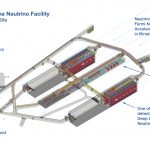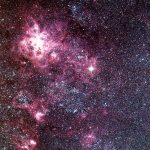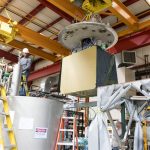This month, Thyssen Mining Inc. was awarded the contract to excavate the gigantic caverns for Fermilab’s Long-Baseline Neutrino Facility. Excavation crews will drill, blast and remove approximately 800,000 tons of rock to create the underground space for LBNF. When complete, the facility will house the enormous particle detector for the international Deep Underground Neutrino Experiment, hosted by Fermilab.
DUNE
All summer long, progress on preparing the Fermilab site for the construction of the Long-Baseline Neutrino Facility has been proceeding at a healthy clip. Now, as summer winds down, that site prep is nearing completion.
From Quanta Magazine, October 2020: This 17-minute podcast episode explores how three physicists stumbled across an unexpected relationship between some of the most ubiquitous objects in math. Hear Fermilab scientist Stephen Parke, DUNE collaborator Deborah Harris of York University, and Fields medalist Terence Tao discuss neutrinos, linear algebra, and the international, Fermilab-hosted Deep Underground Neutrino Experiment.
From Science, Oct. 2, 2020: As U.S. particle physicists start to drum up new ideas for the next decade in a yearlong Snowmass process they have no single big project to push for (or against). Physicists have just started to build the current plan’s centerpiece: The Long-Baseline Neutrino Facility at Fermilab will shoot particles through 1,300 kilometers of rock to the Deep Underground Neutrino Experiment in South Dakota. Fermilab Deputy Director of Research Joe Lykken and Fermilab scientist Vladimir Shiltsev comment on other possible pursuits in high-energy physics.
A scientist, avid runner and Cajun food cook, Bryan Ramson is helping solve the universe’s mysteries as a member of two Fermilab-hosted neutrino experiments: NOvA and the international Deep Underground Neutrino Experiment. Eager to share the joy of science with others, Ramson is active in physics outreach in the Chicago community.
From Scientific American, Sept. 22, 2020: The Chinese JUNO experiment will aim to answer a mystery about the particles’ mass. It will be joined by the international Deep Underground Neutrino Experiment later this decade in its search for answers that neutrinos can provide. Fermilab Deputy Director Joe Lykken weighs in on how neutrinos will address the universe’s pressing questions.
Scientists are testing the components and systems for the international Deep Underground Neutrino Experiment, hosted by Fermilab, with other liquid-argon particle detectors. One such detector is ICEBERG, which is over 10,000 times smaller than DUNE will be. ICEBERG’s measurements are providing insight for future neutrino experiments.
From CERN Courier, Sept. 9, 2020: The first ICHEP meeting since the publication of the update of the European strategy for particle physics covered Higgs and neutrino physics, including results from the CMS collider experiment and the DUNE, NOvA and MicroBooNE neutrino experiments.
From Futurism, Aug. 19, 2020: When an ambitious new Fermilab-hosted experiment called DUNE begins its work, physicists believe they’ll be able to learn a whole lot more about supernova explosions than ever before. That’s because DUNE is expected to be sensitive to an extremely elusive particle called a neutrino that’s blasted far and wide across the cosmos when a star explodes. According to a new paper shared online on Saturday, physicists expect DUNE to scoop up a never-before-detected kind of neutrino and, in doing so, break down why and how stars die in unprecedented detail.




